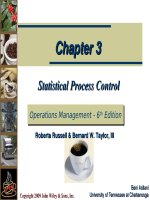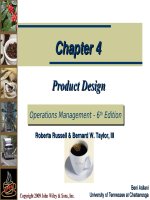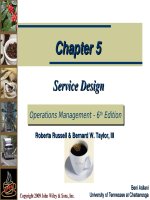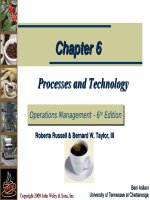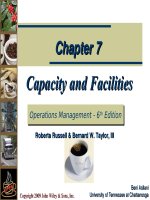Enterprise systems for management 2nd by motiwalla and thompson chapter 03
Bạn đang xem bản rút gọn của tài liệu. Xem và tải ngay bản đầy đủ của tài liệu tại đây (683.82 KB, 41 trang )
CHAPTER 4
DEVELOPMENT LIFE
CYCLE
1
Copyright © 2012 Pearson Education, Inc. Publishing as Prentice Hall
Learning Objectives
•
•
•
•
•
•
•
•
Review the Systems Development Life Cycle (SDLC).
Examine the problems and alternatives with SDLC.
Know the key issues in ERP implementation strategy.
Understand ERP Implementation Life Cycle.
Examine the rapid implementation methodologies.
Compare and contrast SDLC and ERP Life Cycles.
Examine the role of people like top in the ERP Life Cycle.
Understand the importance of the PMO and the project
organization to a successful ERP implementation.
• Know the components of a project organization and the
roles and responsibilities of each.
2
Copyright © 2012 Pearson Education, Inc. Publishing as Prentice Hall
Preview
• There are various technical and organizational
challenges in implementing ERP systems depending on
the organization, scope of implementation, business
processes, and skill level of the end users.
• The System Development Life Cycle (SDLC) provides
useful guidelines to the ERP implementation process.
• Discussion on the key phases of the ERP life cycle with
emphasis on roadblocks in each phase and solutions
available to overcome these roadblocks
3
Copyright © 2012 Pearson Education, Inc. Publishing as Prentice Hall
Systems Development Life Cycle (SDLC)
• SDLC includes a systematic process of planning,
designing, and creating an information system for
organizations.
• It is often better to have a structured methodology to
avoid mishaps and coordinate the design and
development tasks properly among the members of a
large systems development team.
• Systems Approach—Complex problems are broken up
into smaller manageable problems using a systems’
hierarchy, and then developing a solution for each
problem within the hierarchy.
4
Copyright © 2012 Pearson Education, Inc. Publishing as Prentice Hall
Figure 4-1 Traditional SDLC Methodology
5
Copyright © 2012 Pearson Education, Inc. Publishing as Prentice Hall
Figure 4-2 SDLC Approach
6
Copyright © 2012 Pearson Education, Inc. Publishing as Prentice Hall
Rapid SDLC Approaches
• Prototyping
– This approach does not go through the analysis and design
phase.
– It implements a skeleton or a prototype of the actual system with
a focus on data input and output.
– The idea is to demonstrate the system functionality to the users.
– Feedback is incorporated into the new system and demonstrated
back to the users.
– This approach has proven to be very effective with user
interactive systems because the prototype is eventually
converted into a full-scale system.
• End User Development (EUD)
– Users are trained to develop their own applications (e.g., a
departmental employee tracking system with an Access
database).
7
Copyright © 2012 Pearson Education, Inc. Publishing as Prentice Hall
Figure 4-3 Prototype Development
8
Copyright © 2012 Pearson Education, Inc. Publishing as Prentice Hall
Differences between ERP and Other Software
ERP
Other Packaged Software
Millions of dollars
Hundreds to Thousands
Mission critical
Support or productivity
improvement
One to several years
Almost instantly
Requires significant change
Requires some training and
management strategy from beginning support
to end for success; business process
change, training, communications,
etc.
Requires in-house employee time,
consultants and vendor support in
millions of dollars
Requires little or no consulting
support or vendor technical
support
9
Copyright © 2012 Pearson Education, Inc. Publishing as Prentice Hall
ERP Implementation Plan
• Comprehensive
– Involves implementation of the full functionality of the ERP software
in addition to industry-specific modules.
– Requires a high level of business process re-engineering.
• Middle-of-the-Road
– Involves some changes in the core ERP modules and a significant
amount of business process re-engineering.
• Vanilla
– Utilizes core ERP functionality and exploits the best practice
business processes built into the software.
– Business process re-engineering is eliminated.
10
Copyright © 2012 Pearson Education, Inc. Publishing as Prentice Hall
ERP Implementation Methodology
• An ERP development life cycle provides a systematic
approach to implementing ERP software in the changing
but limited-resource organizational environment.
• The traditional ERP life cycle accomplishes one stage at
a time and requires formal milestone approvals prior to
moving to the next stage.
• In a rapid ERP life cycle, once a company commits to
the implementation, employees are empowered to make
the decisions to keep the project moving forward.
11
Copyright © 2012 Pearson Education, Inc. Publishing as Prentice Hall
Figure 4-4 Rapid Application Development Process
12
Copyright © 2012 Pearson Education, Inc. Publishing as Prentice Hall
Traditional ERP Life Cycle
• Scope and Commitment Stage
– In addition to conducting the feasibility study, a scope of the
ERP implementation is developed within the resource and time
requirement.
– Characteristics of the ERP implementation are defined.
– Develop a long-term vision for the new system and a short-term
implementation plan and top management’s commitment.
– Vendor Selection.
13
Copyright © 2012 Pearson Education, Inc. Publishing as Prentice Hall
Figure 4-5 Traditional ERP Life Cycle
14
Copyright © 2012 Pearson Education, Inc. Publishing as Prentice Hall
Traditional ERP Life Cycle (Cont’d)
• Analysis and Design Stage
– A decision on the software is made and decide on consultants
and SMEs.
– Analysis of user requirements.
– Map the differences between the current business process and
the embedded process in the ERP software.
– Design a change management plan, a list of embedded
processes, user interface screens, and customizable reports in
the ERP software.
– Data conversion.
– System conversion.
– Training.
15
Copyright © 2012 Pearson Education, Inc. Publishing as Prentice Hall
Traditional ERP Life Cycle (Cont’d)
• Acquisition & Development Stage
– Purchase the license and build the production version of the
software to be made available to the end-users.
– The tasks identified in the gap analysis are executed at this
stage.
– Change management team works with end-users on
implementing the changes in business processes.
– Data team similarly works on migrating data from the old
system to the new system.
– Finally, the ERP system needs to be configured with proper
security.
16
Copyright © 2012 Pearson Education, Inc. Publishing as Prentice Hall
Traditional ERP Life Cycle (Cont’d)
• Implementation Stage
– Focus is on installing and releasing the system to the end-users
and on monitoring the system release to the end-users.
– System conversion (4 Phases)
• Phased.
• Pilot.
• Parallel.
• Direct Cut or big bang.
– Feedback received from system usage needs to be funneled to
the post-implementation team for ongoing system support.
17
Copyright © 2012 Pearson Education, Inc. Publishing as Prentice Hall
Table 4-2 List of Scopes and Commitments
Gap Analysis
Evaluation of the functions provided by the ERP system
compared with the operational processes necessary to run
your business
Physical Scope
Establishes which sites will be addressed, the
geographical locations of the sites, and the number of
users.
BPR Scope
Will the current processes be refined, replaced, or
eliminated? What users, departments, sites will be
affected?
Technical Scope
How much modification will be done to the ERP software?
What processes will be utilized as is and which will be
customized?
Resource Scope
How much time and budget is allocated for the project?
Implementation
Scope
Which modules should be implemented? How should the
modules be connected to the existing system?
18
Copyright © 2012 Pearson Education, Inc. Publishing as Prentice Hall
Figure 4-6 ERP Conversion Approaches
19
Copyright © 2012 Pearson Education, Inc. Publishing as Prentice Hall
Traditional ERP Life Cycle (Cont’d)
• Operation Stage
– Handover or knowledge transfer is the major activity as support
for the new system is migrated to the help desk and support
staff.
– Training of new users to the system as ERP modules are
released.
– Managing of new releases of the software, installation of
patches and upgrades.
– Managing the software contract with the ERP vendor.
20
Copyright © 2012 Pearson Education, Inc. Publishing as Prentice Hall
Figure 4-7 ERP Life Cycle Phases Summary
21
Copyright © 2012 Pearson Education, Inc. Publishing as Prentice Hall
Role of Change Management
• System failures often occur when the attention is not paid
to change management from the beginning stages.
• A vision for CM needs to be articulated from the first
stage and then revised, monitored, and implemented on
a constant basis.
• SMEs and other internal users have the role of working
with the team and to guide the implementation team on
all the activities of change management.
• Support of the top management as well as skills of the
change management team are essential for successful
implementation.
22
Copyright © 2012 Pearson Education, Inc. Publishing as Prentice Hall
Methodologies used in ERP implementation
• Total Solution (Ernst & Young, LLP)
• Phases
– Value Proposition. Does the solution make sound
business sense?
– Reality Check. Is the organization ready for change?
– Aligned approach. Setting the right expectations that
deliver both short-term and long-term value.
– Success Dimension. Getting the right blend of
people, skills, methods, and management in the
team.
– Delivering Value. Measuring results and celebrating
success.
23
Copyright © 2012 Pearson Education, Inc. Publishing as Prentice Hall
Methodologies used in ERP implementation (Cont’d)
• Fast Track (Deloitte & Touche)
• Phases
– Scoping and Planning: Project definition and scope. Project
planning is initiated.
– Visioning and Targeting: Needs assessment. Vision and targets
identified. As-is modeling.
– Redesign: To-be Modeling. Software design and development.
– Configuration: Software development. Integration test planning.
– Testing and Delivery: Integration testing. Business and system
delivery.
24
Copyright © 2012 Pearson Education, Inc. Publishing as Prentice Hall
Methodologies used in ERP implementation (Cont’d)
• Fast Track (Deloitte & Touche)
• Areas
– Project Management (project organization, risk management,
planning, communications, budgeting, quality assurance).
– IT Architecture (hardware and network selection, installation,
operations, design, development, installation).
– Process and Systems Integrity (security, audit control).
– Change Leadership (leadership, commitment, organizations
design, change-readiness, policies, performance
measurements).
– Training and Documentation (needs assessment, training design
and delivery, management, end-users, operations, and helpdesk.
25
Copyright © 2012 Pearson Education, Inc. Publishing as Prentice Hall




